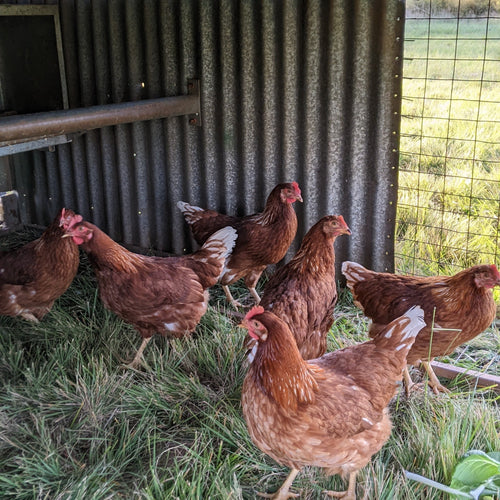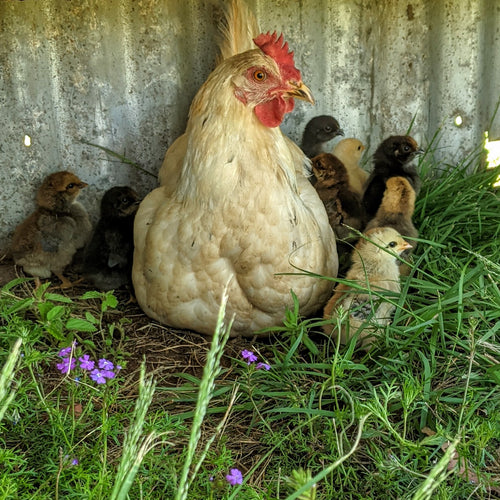Caring for young chicks
If you are incubating eggs and you are as successful as we were, you will end up with chicks to look after. We currently have 33 chicks in a box in our lounge room! I was recently contacted by a lady who was about to buy some chicks and didn't know what to feed them.
| the chicks in their box |
Chicks need three things: a safe, warm place to live; water and food.
When chicks first hatch, they don’t have many feathers, so they need to be kept warm, around the same temperature as the incubator (38degC) at first and then gradually cooling as they get bigger. We keep our chicks in a large wooden box. You don’t have to use a wooden box, any kind of strong, draught-proof box will do. I have seen plastic, cardboard and metal boxes used as well.
We heat the box using a heat lamp and thermostat designed for reptiles. We have both a 60W and a 25W bulb, which we vary depending on the outside temperature (we bought the thermostat and bulbs from Reptile Direct Australia). The top of the box has a metal mesh frame, so stop the chicks flying out and to stop the dogs helping themselves. You can also use incandescent lightbulbs (which we can’t buy anymore) and a thermometer to monitor the temperature in the box. The chicks will tell you if they are too cold, they all huddle under the lamp, and if they are too hot they will be in the opposite corner of the box panting!
We also cover the box with a towel at night to keep out draughts. The box usually starts inside, because the temperature is more stable, and moves outside as the chicks start to smell and make too much noise. After they are a week old or so, they are much stronger and able to handle temperature fluctuations. It is surprising how strong they get so quickly when you see how weak they are after they first hatch.
We line the bottom of the box with newspaper and then a layer of wood shavings. This is supposed to be easier on their little feet. We had a batch of chickens with crocked feet before and I think it was from only having newspaper on the floor of their box. They do tend to eat some wood shavings at first, but it must not matter, as long as they find their chick food as well.
Inside the box we provide the chicks with a small “waterer”, which you can buy from a produce/stock feed store. This is better than a dish of water because the chicks can’t fall in and get wet (and cold) or drown. They seem to find the water by instinct and there’s no need to add anything to the water, although I've read that people add apple cider vinegar or honey to give the chicks an energy boost, especially if they've arrived via post.
I've left the food discussion to last because it’s the most complicated. You can just buy a commercial chick starter crumble, which is formulated for chicks, and usually contains a coccidiostat (a drug to prevent the chicks getting sick from coccidiosis). This is more relevant for large-scale production of chicks and probably unnecessary for more small farm raisers of chicks. A good alternative, if you can find it, is an organic chick crumble. There is one made in Queensland by Country Heritage Feeds. It contains all the same protein and minerals as the commercial crumble, without the drugs.
Now you may want to take things even further and make the chick feed yourself. This is unknown territory for me, we always use some kind bought feed, its just easier, and the chickens have never suffered any problems as a result of our feed choices, but in the interests of self-sufficiency and knowing where your food comes from, you might want to try homemade chick feed. There’s lots of great advice on this site.
Inside the box we provide the chicks with a small “waterer”, which you can buy from a produce/stock feed store. This is better than a dish of water because the chicks can’t fall in and get wet (and cold) or drown. They seem to find the water by instinct and there’s no need to add anything to the water, although I've read that people add apple cider vinegar or honey to give the chicks an energy boost, especially if they've arrived via post.
I've left the food discussion to last because it’s the most complicated. You can just buy a commercial chick starter crumble, which is formulated for chicks, and usually contains a coccidiostat (a drug to prevent the chicks getting sick from coccidiosis). This is more relevant for large-scale production of chicks and probably unnecessary for more small farm raisers of chicks. A good alternative, if you can find it, is an organic chick crumble. There is one made in Queensland by Country Heritage Feeds. It contains all the same protein and minerals as the commercial crumble, without the drugs.
Now you may want to take things even further and make the chick feed yourself. This is unknown territory for me, we always use some kind bought feed, its just easier, and the chickens have never suffered any problems as a result of our feed choices, but in the interests of self-sufficiency and knowing where your food comes from, you might want to try homemade chick feed. There’s lots of great advice on this site.
Have I forgotten anything this time? Do you have any other tips?























Leave a comment